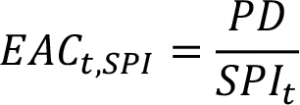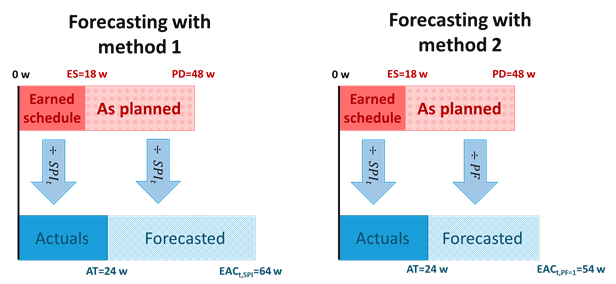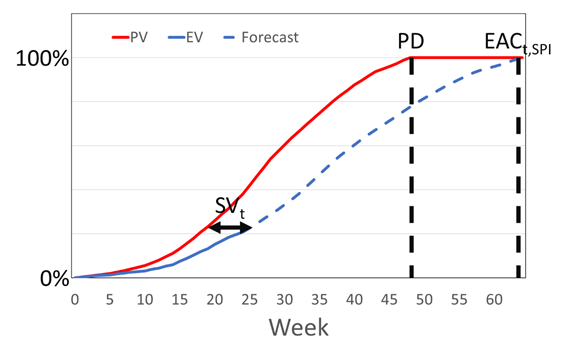Time forecasting techniques with Earned Schedule
You are halfway through your project and you want to know if you are still going to achieve your project objectives. By using an Earned Value Management System, you know how to estimate your total expected costs (Estimate at Completion), but what about your deadline? Based on your current information, can you say something about the expected finish date of your project? This blog gives you an overview of how to use Earned Schedule to predict your project finish date.
Summary Earned Schedule Management

An Earned Value Management system, together with Earned Schedule , can integrate time and cost control effectively.
In our previous blog, we have introduced Earned Schedule as a technique you can use to measure the estimated timing of your project. Earned Schedule Management (ESM) uses the same data as Earned Value Management (EVM) does but translates the variations into time instead of cost. In this way, for example, you can say halfway through your project, how many weeks you are lagging behind schedule. A schedule variance expressed in time is much more appealing to use than expressing it in euro’s as is the case in conventional EVM.
The table shows the parameters used in this blog along with an example in the last column. In our example, we are in week 24 (Actual Time), the value realized in week 24 was originally planned for week 18 to be completed (Earned Schedule). This means that we are 6 weeks behind schedule (This is our Schedule Variance (t)). Using Earned Schedule, we will discuss in this blog how you can use this data to make predictions about the expected finish date of your project (Estimate at Completion (t)).

Time Forecasting with Earned Schedule
1. Current Variance is typical for future work
In our example, we are 6 weeks behind while 24 weeks elapsed. If we continue this pace into the future, then we expect that, at the planned finish date of 48 weeks, we will be 12 weeks late. This method, of using the current Schedule Performance Index (SPIt) to make a forecast about the expected finish date (EACt), can be applied, using the following formula:

In our example, this means that ![]() .
.
This method cannot hide behind “wishful thinking”, precisely what EVM and ESM techniques are intended for. For this reason, the IEACt, the Independent EACt, is often discussed. The IEACt generally means that only the calculation method above can be used. If the EACt deviates from the IEACt, an explanation by e.g. the project manager is required for this. This also applies to the EAC€ introduced in the previous blog.
2. Use of the Performance Factor
Instead of using the SPIt, which reflects the performance of the whole project until the current date, the Performance Factor could be used for future performance, in this case the following equation is used:

PF is the expected performance for future work. When PF=1, this means that you expect future work to be carried out as planned (see method 3). Otherwise, when the current performance is characteristic for the entire project so far, when PF=SPIt , this method equals method 1 as described above.
By using the Performance Factor, you can choose to work with the performance of only the past periods. A strategy for determining your PF could be to look at the difference in Earned Schedule between your current period and 4 weeks ago and divide this by 4 weeks. This way, you have a Performance Factor that says more about your current performance than when you take the SPIt of the whole project.
3. Variance is not recurring
A special variation of using the Performance Factor is to set the Performance Factor to 1. This means that we are going to rely on future work being carried out as initially planned. Only the delay incurred so far is added to the scheduled finish date:
![]()
This method may be justified when the variations that have occurred so far were so unique that they will not reflect performance in future work. This can be the case when the work that has been carried out is completely different (e.g. in team, organization, WBS etc.) from future work. Or some major events or issues have occurred.
In our example, this would mean that![]()

Fig. 1: Schematic representation of the different methods of forecasting with earned schedule. In method 1 SPIt is used to calculate the forecasted finish date EACt,SPI, while in method 2 the Performance Factor is used for this purpose, where in this figure PF=1 is chosen as an example for method 3.
4. Other methods
Like the previous post, it is possible for a project manager to work with a Management Estimate based on other methods, or that our Planned Date remains the best prediction. Although these may be better predictions, this is not aligned with EVM or ESM philosophy. We believe that an EACt specified by a project manager who deviates significantly from the independently calculated EACt,SPI, requires an explanation. The independently calculated EACt,SPI can thus function as a warning light.

Figure 2: A graphical representation of how Earned Schedule can predict the planned finish date of the project. In red the Planned Value curve as can be extracted from a planning tool. The solid blue curve is the actual progress of the project, the earned value. The dashed curve represents the forecasted earned value with method 1 used as example.
Conclusion
Earned Value Management can provide a transparent prediction of the expected terminal costs of your project. ESM is a nice addition, that needs the same data as EVM, to be able to predict the expected finish date of your project. Are you already using EVM? Then adding the described Earned Schedule method is of great value. Primaned would like to help you with advice, training and/or the right tools.
Reference
[1] Forecasting Schedule Variance using Earned Schedule, Walt Lipke, Feb. 2017, PM World Journal Vol. VI, Issue II



